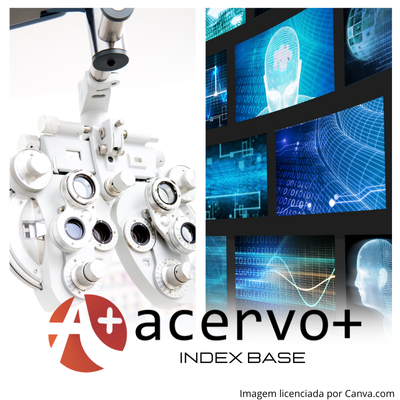O impacto das novas tecnologias digitais na acuidade visual de crianças e adolescentes
##plugins.themes.bootstrap3.article.main##
Resumo
Objetivo: Analisar como ocorre o desenvolvimento de síndromes oculares a partir do uso de tecnologias digitais e, ainda, como prevenir o aparecimento e a progressão de patologias e distúrbios visuais em crianças e adolescentes. Revisão bibliográfica: Atualmente, diversas atividades que antes eram realizadas de forma física ou manual têm sido realizadas através das tecnologias digitais, seja para estudo, lazer e/ou trabalho. Com essas modificações, surgem preocupações acerca da sobrecarga sensorial, sobretudo visual, associada ao uso excessivo de dispositivos eletrônicos. Estudos indicam correlações entre o uso prolongado de telas e o desenvolvimento de problemas oculares, como miopia, além de sintomas da Síndrome da Visão do Computador, como olhos secos e visão turva. Além disso, em crianças, ocorre o agravamento do problema pela falta de percepção das alterações visuais, o que pode resultar em diagnósticos tardios. Considerações finais: É importante que sejam realizadas mais pesquisas para compreender melhor os impactos do uso de telas, buscando formas de tratamento para os sintomas oculares que parecem ser decorrentes do uso excessivo de telas. Como forma de minimizar esse impacto, recomenda-se uma exposição limitada às telas, supervisionadas por responsáveis, especialmente em crianças menores de dois anos.
##plugins.themes.bootstrap3.article.details##
Copyright © | Todos os direitos reservados.
A revista detém os direitos autorais exclusivos de publicação deste artigo nos termos da lei 9610/98.
Reprodução parcial
É livre o uso de partes do texto, figuras e questionário do artigo, sendo obrigatória a citação dos autores e revista.
Reprodução total
É expressamente proibida, devendo ser autorizada pela revista.
Referências
2. EISENSTEIN E. Crianças, adolescentes e a era digital: benefícios e riscos. Revista Acadêmica Licencia e Acturas, 2023; 11(1).
3. ENTHOVEN CA, et al. The impact of computer use on myopia development in childhood: The Generation R Study. Prev Med, 2020; 132: 105988.
4. FONSECA EC, et al. Olho seco: etiopatogenia e tratamento. Arq Bras Oftalmol, 2010; 73(2): 197-203.
5. GOMES ACG, et al. Miopia causada pelo uso de telas: uma revisão de literatura, 2020; 79(5): 350-353.
6. GOIS C, et al. Efeitos e consequências do uso excessivo de dispositivos tecnológicos no sistema visual. Semana De Pesquisa Da Unit - Alagoas, 2021.
7. HAMBURGUER JL, et al. The visual consequences of virtual school: acute eye symptoms in healthy children. J AAPOS, 2022; 26(1): 2.e1-2.e5.
8. KIM J, et al. Association between Exposure to Smartphones and Ocular Health in Adolescents. Ophthalmic Epidemiol, 2016; 23(4): 269-76.
9. LEE YY, et al. What factors are associated with myopia in young adults? A survey study in Taiwan Military Conscripts. Invest Ophthalmol Vis Sci, 2013; 54(2): 1026–33.
10. MOHAN A, et al. Prevalence and risk factor assessment of digital eye strain among children using online e learning during the COVID-19 pandemic: Digital eye strain among kids (DESK study-1). Indian journal of ophthalmology, 2021; 69(1): 140-144.
11. MOON JH, et al. Smartphone use is a risk factor for pediatric dry eye disease according to region and age: a case control study. BMC Ophthalmol, 2016; 16: 188.
12. MORAES IKS, et al. Uso de telas pela população pediátrica e seus impactos oftalmológicos a curto e a longo prazo: uma revisão sistemática. Brazilian Journal of Development, 2022; 8(10): 66571:66586.
13. PERIN AN, et al. Ergophthalmology in accounting offices: the computer vision syndrome (CVS). Revista Brasileira de Oftalmologia, 2017; 76(3): 144-9.
14. QUEIROZ PHB, et al. O impacto do tempo de tela no crescimento e desenvolvimento infantil. Revista Saúde em Foco, 2021; 14.
15. SHEPPARD AL e WOLFFSOHN JS. Digital eye strain: prevalence, measurement and amelioration. BMJ open ophthalmology, 2013; 3(1): e000146.
16. WOJCIECHOWSKI R e HYSI GP. Focusing in on the complex genetics of myopia. PLoS Genet, 2013; 9 (4): e1003442.
17. ZHOU S, et al. Association between parents’ attitudes and behaviors toward children’s visual care and myopia risk in school-aged children. Medicine (Baltimore), 2017; 96(52): e9270.

